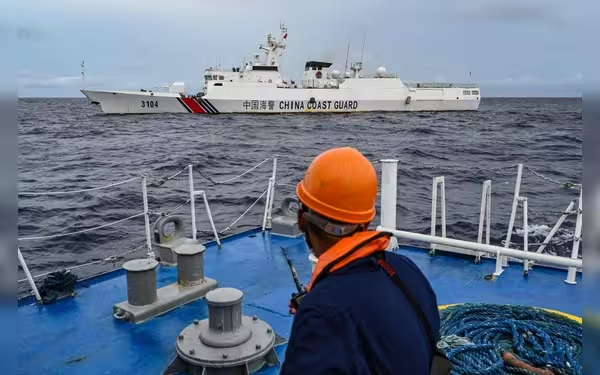Saturday, November 16, 2024 08:47 PM
China Reasserts Territorial Claims in South China Sea
- China reaffirms claims around Scarborough Shoal.
- Philippines enacts laws defining maritime boundaries.
- Tensions escalate between China and the Philippines.
 Image Credits: menafn
Image Credits: menafnChina reaffirms its territorial claims in the South China Sea, escalating tensions with the Philippines following new maritime laws.
The South China Sea has long been a region of contention, with various nations asserting their claims over its waters. Recently, tensions have escalated as China reaffirmed its territorial claims around a disputed reef, known as Huangyan Dao in Chinese and Scarborough Shoal in English. This development comes just days after the Philippines established its own maritime boundaries, further complicating the already fraught situation in these contested waters.
On a significant day for Philippine maritime policy, President Ferdinand Marcos signed two laws aimed at defining the country's sea waters. These laws not only delineate the Philippines' territorial waters but also establish fixed lanes for foreign vessels. This move was met with immediate backlash from China, which summoned the Philippine ambassador to express its discontent. China's foreign ministry stated that the Philippines' actions "severely violate China's territorial sovereignty and maritime rights and interests in the South China Sea." This statement underscores the ongoing friction between the two nations over maritime rights.
China's assertion of its claims is not new. The country took control of Huangyan Dao in 2012, a strategic location that lies closest to the Philippines. Despite an international ruling that deemed China's claims to most of the South China Sea as lacking legal basis, Beijing has continued to disregard this decision. The Philippines' recent Maritime Zones Act, which aligns with the United Nations Convention on the Law of the Sea, aims to clarify the waters that fall within its jurisdiction, including areas that China also claims.
In addition to the Maritime Zones Act, the Philippines also introduced the Archipelagic Sea Lanes Act. This law empowers the president to designate specific sea and air routes for foreign vessels and aircraft, ensuring that national security is not compromised. President Marcos emphasized the importance of these laws during the signing ceremony, highlighting the Philippines' commitment to safeguarding its maritime interests.
China's response has been assertive, with its coast guard vowing to enhance patrols and law enforcement in the waters surrounding Scarborough Shoal. The Chinese government has accused the Philippines of sending military and coast guard vessels into areas it claims, describing these actions as provocations. Reports indicate that Chinese vessels have engaged in aggressive tactics, including ramming and blocking Philippine ships, which raises concerns about the potential for conflict in the region.
As the situation unfolds, it is clear that the South China Sea remains a flashpoint for geopolitical tensions. The actions of both China and the Philippines will be closely monitored by other nations in the region and beyond. The ongoing disputes highlight the complexities of international maritime law and the challenges faced by countries in asserting their rights over contested waters. It is essential for all parties involved to engage in dialogue and seek peaceful resolutions to avoid escalation and ensure stability in this vital maritime area.













